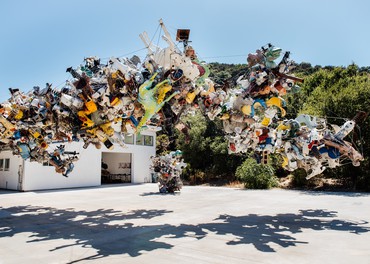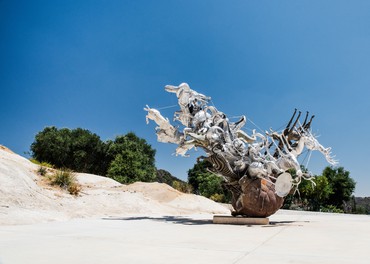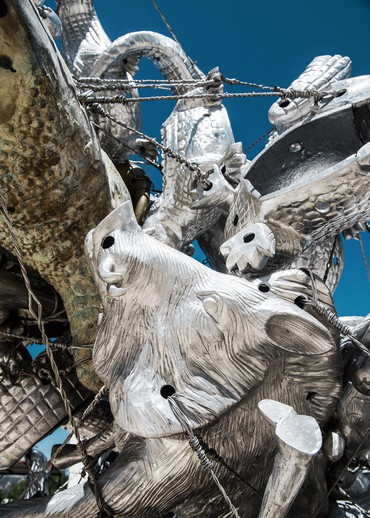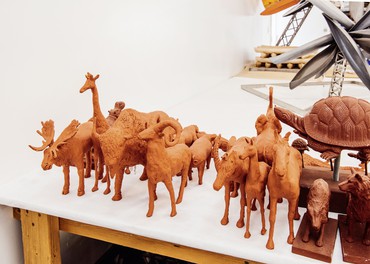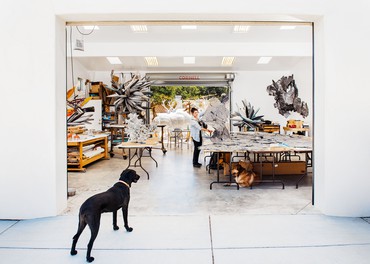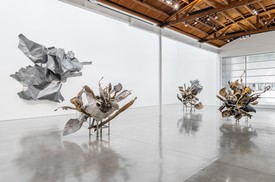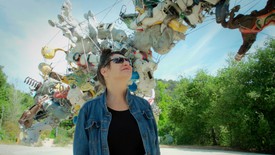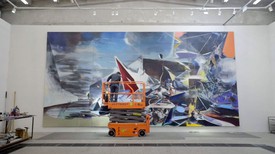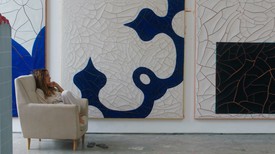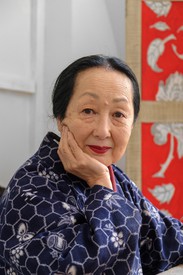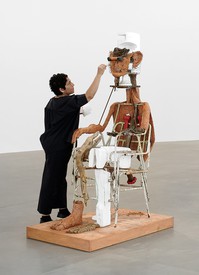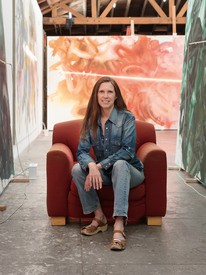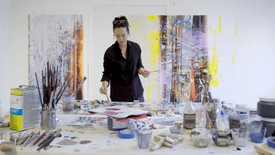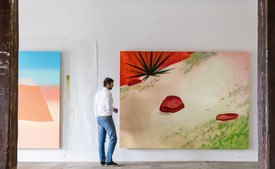
Laura Fried is a curator and writer living in Los Angeles. She has produced screenings, exhibitions, interventions, and performances with a wide variety of artists. She was the artistic director of the Seattle Art Fair (2016 and 2017) and is a co-founder and director of Active Cultures, a nonprofit organization that explores the confluence of food and art in contemporary life. Fried has written for Flash Art International, Frieze, Mousse, and the Los Angeles Review of Books.
On a sprawling mesa in Topanga Canyon, flush with chaparral and oak, Nancy Rubins’s elephantine, cascading sculpture Our Friend Fluid Metal (2014) rests atop a massive concrete pad. When first presented, at Gagosian on West 21st Street, the work undulated outward from the white wall, grasping and stretching into space while seeming to collapse ceiling and ground in the capacious gallery. Here at Rubins’s California studio, the collision of rust and paint, of carousel-horse legs and cartoon-turtle grins, contorts and thrusts against the hot pale-blue sky and the rippling topography. Out of doors, with its heavy base on full display (in a gallery that base would hide behind a wall), Our Friend Fluid Metal reveals its mechanics full tilt. Made through Rubins’s long-tested method of using tension cables to rig her objects, their clusters building off a system of T-bars that protrude like branches from a central arm, the work is a dense bricolage of coiled metal, of punctured limbs and heads, all gesturing out to the hills and trees.
Our Friend Fluid Metal and its smaller companion works marked a departure for Rubins, who had for years been largely occupied with her formidable series of suspended canoes. Comprised of decommissioned playground equipment—spring-bouncing rockets and cartoon animals that had seen years of use, rust, and repainting—these new sculptures had a specificity that at first proved challenging for Rubins. They sat on the property for two years until she felt ready to deploy them. Recognizing that their “objectness was irreversible,” she finally penetrated what she called their “pop-object quality” to see that the material they were made of was itself at a critical cusp in its life span. The same thick aluminum that made up the airplane parts of her earlier sculptures was evident here, as if recuperated from postwar scrap-metal heaps, brought to life by a surge of playground-building, then abandoned as junk some seventy years later. With an archaeologist’s eye, Rubins came to see each of these forms as time stamped, standing just at the threshold of disuse and abandon before the aluminum was again melted down. With this attention to the material’s potency—to the history it wears on its surface—the artist then constructed each work as a dense composition of form, color, and line, making the playground character begin to disappear into the voluminous whole.
If Rubins saw a historical connection between her airplane and playground parts, the evolution of the Our Friend series typifies her larger practice, where disparate bodies of work not only coexist but are bound within systems of continua. This interconnectedness—which seems to touch all facets of her work—is visible both in and outside the studio. In the studio building this summer, I saw multiple ongoing projects sharing space: the sizable, meticulously finished Monochrome maquettes; object studies rendered in wood or epoxy; and clusters of tables together holding a mass of graphite drawings. On the sides of the studio are loading doors through which the occasional breezy gust comes in, rustling the more fragile of the objects inside. Across the property, older work is scattered alongside new, along with vestiges of some sculptures by the artist’s late husband, Chris Burden. In addition to Rubins’s and Burden’s respective studio buildings, the rolling land is dotted with concrete pads, rigging armatures, sheds, and the like—the necessities required for the monumental production involved in constructing works at Rubins’s characteristic scale.
Out of doors, with its heavy base on full display, “Our Friend Fluid Metal” reveals its mechanics full tilt.
Laura Fried
On the mesa, one can imagine the marking of time by the spread of buildings and sculptures, and by the continuous transformation of the land. The dramatic vistas, and the machinery that supports Rubins’s practice, together imply an ecosystem that took decades to build and continues to be fundamental to her life and work. The property has been a thirty-year project. Burden purchased the land in 1981; in 1984 he and Rubins began living there, camping out until the completion of the house, in 1988. As they added new parcels to the property, they eventually built a road and laid electricity and phone lines. Once they had moved from tents into the house, the studio spaces began to take shape. Today, the avocado orchards that once dotted the hillside have been largely taken over by oaks, whose growth Rubins has watched from their sprouting to the scattered but lush forest they have become. As her three dogs sprint up the hills and around the cacti, she tells me about the intense effort, and perhaps latent anxiety, that goes into fire preparedness each season.
Topanga Canyon was already positioned as a kind of bohemia before Burden bought the land. Rendered by figures ranging from Neil Young to Thomas Coraghessan Boyle, the characterization endures: Topanga is known as an isolated retreat from Los Angeles, a favorite refuge for writers, musicians, and artists. George Herms and Wallace Berman were among its more storied dwellers, and artists across generations (notably Mary Corse, who originally introduced Burden to Topanga) continue to live and work there. Rubins has seen Topanga through this history—and one can see how the land she nurtured with Burden for so many years persists as a powerful force that helps shape her work.
The studio has recently been populated with a new species of object, Rubins’s latest focus. As she tells it, her longtime supplier of metal junk, whom she calls Mr. Huffman, said to her plainly one day, “Want some pigs?” Huffman has for decades been her primary source for airplane parts, canoes, and playground animals. He had recently come into the possession of a world of bronze and cast-iron pigs, giraffes, storks, tortoises, wolves, and other creatures both wild and domestic. The menagerie now congregates on the long driveway leading up to Rubins’s studio, as if lining up to enter her ark. It is easy to personify these animals—and such ready prosopopoeia makes their objectness a fascinating problem for Rubins. As she was with the playground equipment, she is keen to explore the ways in which such specific figuration can be abstracted into new sculptural form. In beginning a sculpture, she fashions each figure first out of clay, then somewhat crudely out of wire and epoxy, exploring the sculptural possibilities in maquette form. In the studio this summer, red clay versions of a moose, a buffalo, and bighorn sheep stood beside a cluster of epoxy versions of other animals, and beside scale models of the sculptures themselves.
Three of these sculptures were in process outdoors this summer as Rubins prepared for an upcoming exhibition. The construction of each work is necessarily a complex endeavor, involving a devoted team of studio assistants and engineers who not only build the works but also help Rubins with such logistics as transporting the sculpture from a recently poured concrete pad in Topanga, down the hairpin switchbacks to the canyon’s main road, and on to their ultimate destination. This new project is literally Rubins’s heaviest to date; each object (each animal, that is) weighs more than any previous individual sculpture. Yet it remains critical for Rubins to maintain the possibility of spontaneity. Her hand is perhaps most evident in her attention to key formal decisions and details (the head this way, the cable here, the base visible there) in the moment of the rigging itself. This apparent contradiction in her process—at once meticulously engineered and highly improvisational—is what allows these telescoping sculptures to appear both heavily designed (as they indeed are) and simultaneously, and wondrously, propelled by their own momentum.
While Rubins is keen on the temporal qualities and conditions of her materials, she is equally invested in the painterly possibilities available in a sculptural practice. On first encounter with Huffman’s animal objects, she was struck by their conspicuous seams and cheap Bondo welding—imperfections that offered promising formal possibilities, as inconsistencies in the finish began to hold their own energy. In one new sculpture the back of a giant tortoise lies askew on a square concrete base on the ground. Piled atop it, a buckled-together menagerie stacks up and outward toward the sky. You can see the brushed and welded surface of a zebra hoof, or the base of a stork whose neck is buried tight in the compact stuffing of figures at the base. Here the cables can be read as a kind of violent binding of the creatures, puncturing and muzzling their snouts, hooves, and limbs. The tensegrity that holds these limbs and torsos taut reveals a quality of line—an intricate drawing in space—that offers a kind of astronomical charting of these rapturous beasts. And yet, once again, the density of the composition gives way to a compression of form, and further to a dynamic interplay of color and line, surface and depth. The creatures themselves, writhing and climbing into space, offer a powerful expression of gesture.
If Rubins’s sculptures evince a material density, the drawings are almost a pure exercise of that impulse. She describes the marks on paper as a collection of energy: each mark serves the expression of the whole, and each sheet works in service of the resulting installation on the wall. The artist’s graphite drawings have been a critical through-line in her practice for decades, manifest even in the way they take up space inside her studio. Alongside the neat rows of epoxy animals, and the larger, finished maquettes of her earlier Monochromes, stands a series of tables spilling over with these graphite sheets. In one corner of the building an intricate web of these drawings clings to the walls, while lurching into space at various creases and seams. Rubins has always treated this work as a sculptural form, a body that attaches itself delicately to architecture. Just as she deftly elides the inherent contradictions that hold her monumental sculptures in tension, here she eschews both the vulnerability of paper and the weighty impression of the dense graphite marks, colliding the boundaries of sculpture and drawing together.
Like her attention to the land, Rubins’s methodologies are at once perennial, studied, and improvisational, fundamentally collaborative while also deeply personal. Her work and the way she speaks about it have long seemed touched by a geological as well as a cosmic relationship to material and time. During her days at the University of California, Davis, Rubins explored the possibilities of clay, and she has spoken of the capacity of ceramics to hold time within them; but a finished ceramic object, which seems to arrest time, ultimately held no interest for her. Rather, what holds value for her is an object’s power to convey a kind of geological stratum, evidence of its time on earth.
Rubins invests her choices of materials with a consideration of how these metals—and we ourselves—experience time in relation to the land, how we discover the marks of time and come to acknowledge it. Where she saw the avocado orchards on the property fade away, she also witnessed the growth of the now twenty- and thirty-year oaks—and just as the canyon mesa makes its time apparent to her, she intends her sculptures to carry and convey similar traces of temporal strata, the metal holding a prehistory as well as a latent fate. As the animals emerge out of the earth, fighting their own powerful gravitational pull, like prehistoric fossils finding the surface, so too do they drive up and out toward the atmosphere, as if stretching toward an evaporating end.
Artwork © Nancy Rubins; photos: Brian Guido


